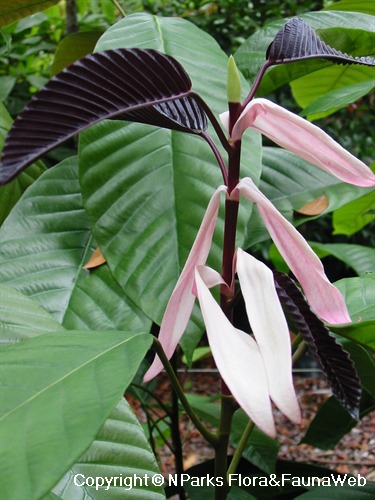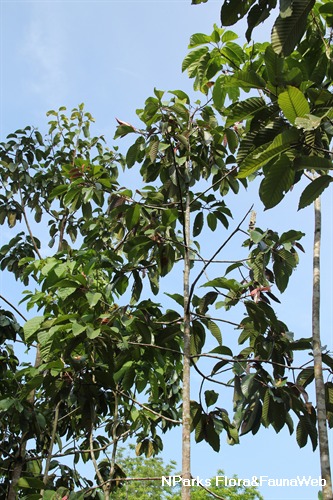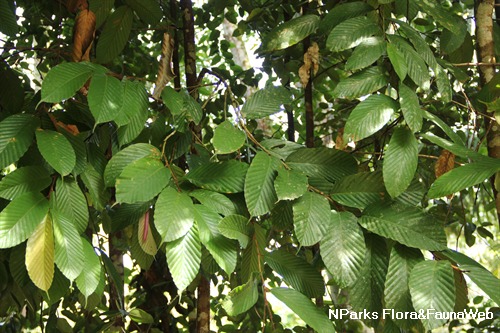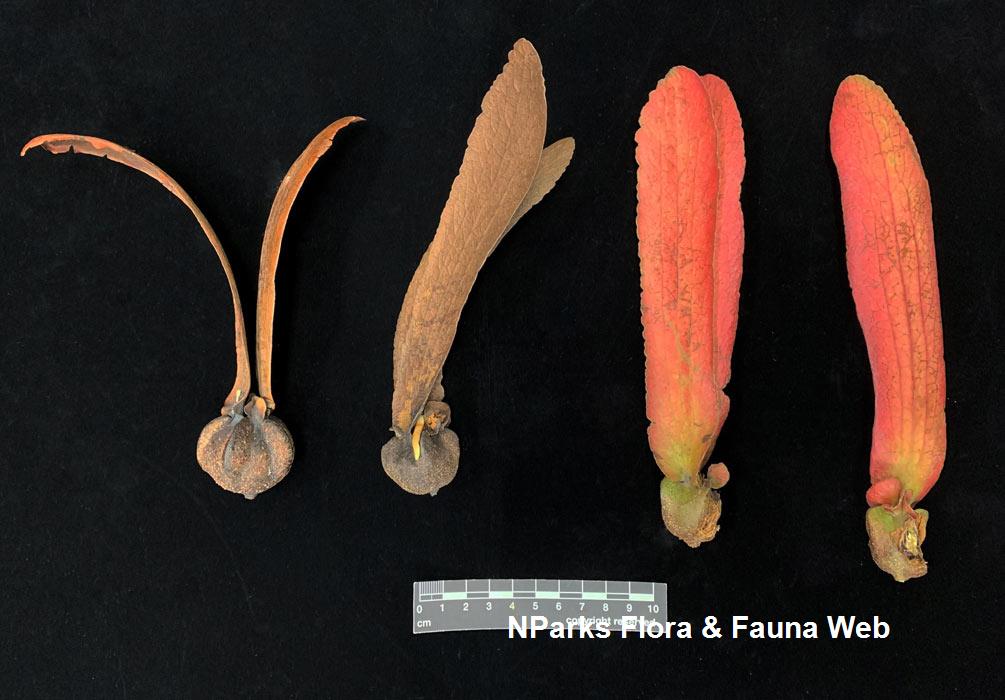
Back
Dipterocarpus grandiflorus (Blanco) Blanco
| Family Name: | Dipterocarpaceae |
| Synonyms: | Dipterocarpus griffithii |
| Common Name: | Keruing Belimbing, Keruing Pekat, Meluit, Apitong |
Name
Classifications and Characteristics
| Plant Division | Angiosperms (Flowering Seed Plants) (Dicotyledon) |
|---|---|
| Plant Growth Form | Tree (Big (>30m)) |
| Lifespan (in Singapore) | Perennial |
| Mode of Nutrition | Autotrophic |
| Plant Shape | Irregular |
| Maximum Height | 45 m |
Biogeography
| Native Distribution | Andaman Islands, Myanmar, Vietnam, Thailand, Peninsular Malaysia, Singapore, Borneo and Philippines. |
|---|---|
| Native Habitat | Terrestrial (Primary Rainforest, Secondary Rainforest) |
| Preferred Climate Zone | Tropical, Sub-Tropical / Monsoonal |
| Local Conservation Status | Native to Singapore (Critically Endangered (CR)) |
Description and Ethnobotany
| Growth Form | It is a tree, up to 45 m tall. |
|---|---|
| Foliage | Its alternate, stalked leaves have thick leathery leaf blades that are broadly elliptic, and 10-18 cm by 5-12 cm. |
| Flowers | Its flowers are found on unbranched, slender shoots that are up to 18 cm long. |
| Fruit | Its stoutly-stalked 5-flanged, ellipsoid fruit is 6-7 by 3.5 cm, and winged by two enlarged sepals to 22 by 3 cm, and three minor sepals to 2 by 1.5 cm. |
| Habitat | It grows on dry ridges, and low hills below 400 m altitude. |
| Cultivation | It can be propagated by seed. |
| Etymology | Greek di, two; Greek pteron, wing; Greek karpos, fruit, referring to the two-winged fruit; Latin grandiflorus, large flowers, referring to the species' flowers. |
| Ethnobotanical Uses | Timber & Products: The timber is used for construction and medium-grade furniture. Others: Its oil is used to make varnish. |
Landscaping Features
| Landscaping | It is suitable for a large garden or park. |
|---|---|
| Landscape Uses | General, Parks & Gardens |
Fauna, Pollination and Dispersal
| Pollination Method(s) | Biotic (Fauna) |
|---|---|
| Seed or Spore Dispersal | Abiotic |
Plant Care and Propagation
| Light Preference | Full Sun, Semi-Shade |
|---|---|
| Water Preference | Moderate Water |
| Plant Growth Rate | Moderate |
| Rootzone Tolerance | Moist Soils, Well-Drained Soils, Fertile Loamy Soils |
| Propagation Method | Seed |
Foliar
| Foliage Retention | Evergreen |
|---|---|
| Mature Foliage Colour(s) | Green, Purple, Pink |
| Mature Foliage Texture(s) | Leathery |
| Prominent Young Flush Colour(s) | Black, Purple |
| Foliar Modification | Stipule |
| Foliar Type | Simple / Unifoliate |
| Foliar Arrangement Along Stem | Alternate |
| Foliar Attachment to Stem | Petiolate |
| Foliar Shape(s) | Non-Palm Foliage (Elliptical) |
| Foliar Venation | Pinnate / Net |
| Foliar Margin | Entire |
| Leaf Area Index (LAI) for Green Plot Ratio | 3.0 (Tree - Intermediate Canopy) |
Floral (Angiosperm)
| Flower & Plant Sexuality | Bisexual Flowers |
| Flower Colour(s) | Cream / Off-White |
|---|---|
| Flower Grouping | Cluster / Inflorescence |
| Flower Location | Axillary |
| Flower Symmetry | Radial |
Fruit, Seed and Spore
| Mature Fruit Colour(s) | Brown |
|---|---|
| Fruit Classification | Simple Fruit |
| Fruit Type | Indehiscent Dry Fruit , Nut / Nutlet |
Image Repository
Others
| Master ID | 1564 |
|---|---|
| Species ID | 2857 |
| Flora Disclaimer | The information in this website has been compiled from reliable sources, such as reference works on medicinal plants. It is not a substitute for medical advice or treatment and NParks does not purport to provide any medical advice. Readers should always consult his/her physician before using or consuming a plant for medicinal purposes. |





